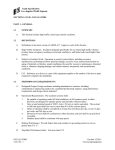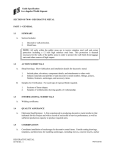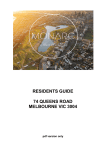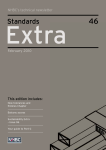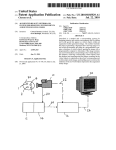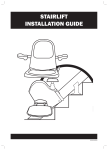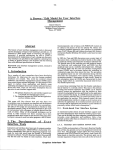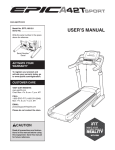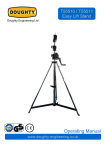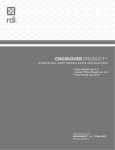Download 14 32 00 Moving Walks - Los Angeles World Airports
Transcript
Guide Specification SECTION 14 32 00 - MOVING WALKS PART 1 - GENERAL 1.1 SUMMARY A. This Section includes moving walks. 1. B. 1.2 BMS components will be incorporated into the moving walk work. Coordinate with the BMS component contractors to incorporate BMS components during the course of the Work. Single Subcontract Responsibilities: Refer to Section 14 20 00 Vertical Transportation, General for the requirements of single subcontract responsibilities for moving walks. DEFINITIONS A. Definitions in the latest version of ASME A17.1 apply to work of this Section. B. Defective Moving Walk Work: Operation or control system failure, including excessive malfunctions; performances below specified ratings; excessive wear; unusual deterioration or aging of materials or finishes; unsafe conditions; the need for excessive maintenance; abnormal noise or vibration; and similar unusual, unexpected, and unsatisfactory conditions. C. Reference to a device or a part of the equipment applies to the number of devices or parts required to complete the installation. 1.3 PERFORMANCE REQUIREMENTS A. Operational Requirements: The moving walk systems shall: 1. Be capable of operating under full load conditions, at full contract speed, in either direction, and designed to operate quietly and smoothly without bounce. 2. Have a rated speed of 100 ft./min. (0.51 m/s) or the metric equivalent. The no-load to full load speed shall not vary more than 4% from the contract speed. 3. Hours of operation shall be considered as twenty-four (24) hours per day, seven (7) days per week. 4. Handrail speed shall be consistent with pallet speed. B. Structural Performance of Balustrades: Per ASME A17.1-2004. Provide balustrades designed to resist the simultaneous application of a static lateral force of 40 lb. /ft. and a vertical load of 50 lbf/ft, both applied at the top of the handrail stand. C. Environmental Requirements: Moving walks shall be capable of operating with full-specified performance capability while exposed to the design climatic and environmental conditions: Climatic and environmental design conditions are available from the mechanical engineer. MOVING WALKS 14 32 00 - 1 Added 12/2010 Conveying Equipment Guide Specification 1.4 QUALITY ASSURANCE A. Manufacturer Qualifications: Refer to Section 14 20 00, Vertical Transportation, General. B. Installer Qualifications: Refer to Section 14 20 00, Vertical Transportation, General. C. Professional Engineer Qualifications: Professional Engineer Qualifications: Refer to Section 14 20 00, Vertical Transportation, General. D. Standards: The following standards shall govern the moving walk work. Where standards conflict, the standard with the more stringent requirements shall be applicable. 1. Moving Walk Code: In addition to requirements of authorities having jurisdiction, comply with the latest edition of ASME A17.1, "Safety Code for Elevators and Escalators", ASME A17.2 “Guide for Inspection of Elevators, Escalators and Moving Walks”, and ASME A17.5 “Requirements for Elevator and Escalator Electrical Equipment”, including supplements, as published by the American Society of Mechanical Engineers. Wherever “Code” is referred to in the moving walk specification, the ASME A17.1 Code shall be implied. 2. Electrical Code: For electrical work included in the moving walk work, comply with the National Electric Code (NFPA 70), ASME A17.5, all applicable local codes, and the authorities having jurisdiction. 3. Welding: Comply with AWS standards. 4. Americans with Disabilities Act (ADA). 5. Building Code of the City of Los Angeles and the following: a. California Code of Regulations (CCR), Title 8. b. City of Los Angeles Elevator Code. E. Electrical Devices and Equipment: Refer to Section 14 20 00, Vertical Transportation, General. F. Manufacturer: Provide all moving walks components from a single source. Where equipment or operation varies from those described, the manufacturer shall provide a complete description of those variations as required under Section 14 20 00, VERTICAL TRANSPORTATION, GENERAL, Article QUALITY ASSURANCE, paragraph 'Contractor Statement'. G. Testing and Inspections: Refer to Section 14 20 00, Vertical Transportation, General. NOTE: The intent of this Guide Specification is to specify the robust equipment with the maintainability features required by APTA. Compliance with other APTA Guideline requirements that do not apply to escalators in an interior airport environment is not necessary. 1.5 SUBMITTALS A. General: Refer to Section 14 20 00, VERTICAL TRANSPORTATION, GENERAL. MOVING WALKS 14 32 00 - 2 Added 12/2010 Conveying Equipment Guide Specification B. Warranty and Maintenance Agreement: Warranties and maintenance agreements are required, refer to Section 14 20 00, VERTICAL TRANSPORTATION, GENERAL and Exhibit A. C. Maintenance and Operating Manuals: Maintenance and operating manuals are required, refer to Section 14 20 00, VERTICAL TRANSPORTATION, GENERAL. D. Shop Drawings: Submit complete information for all components for review prior to the fabrication of the moving walk work. Items which shall be detailed shall include the following: 1. Fully dimensioned layout for moving walks in plan, elevation, and section at a scale of ¼” = 1’-0”. Indicate component locations, structural supports, access spaces, and points of entry. Indicate the interface of the moving walk work with adjacent work, including but not limited to, the following: a. 2. Load assumptions for maximum loads imposed on trusses requiring load transfer to building structural framing, individual weight of principal components and their dead and live load reactions at points of support, electrical characteristics and connection requirements, and any other information requested by the Architect. a. Pallet linkage details for material, configuration, arrangement, and lubrication requirements. 4. Drive motor, controller, safety devices, and switches including brakes. 5. Complete layout of electrical system including motor, control panel; disconnect switches; panelboards, truss lighting, light fixtures and light switches; receptacles; and safety, surveillance and control devices. 6. Complete single line wiring diagrams of all circuits in the moving walk systems. Show component location within each system, terminals with numbers, connection between components, conductor identification, interface connections with remote surveillance and control system, include an explanation of basic operation. Provide a record set of drawings with all changes made during the installation of the work. At the completion of the job, submit to the Owner for the Owner's use a complete set of "AS INSTALLED" plans and wiring diagrams. Product Data: Submit manufacturers design data, material specifications, installation instructions, and other data pertinent to the components used in the moving walk work. 1. Provide the Owner with special tools, solid state microprocessor tools, including appropriate programs relative to the specific type of microprocessor or computer controls installed on this project, necessary to trouble shoot, service, test and maintain the moving walks. Special tools become the property of the Owner. Tools provided shall be useable throughout the life of the equipment. a. F. Structural Calculations: Submit, for information only, copies of structural calculations indicating load assumptions. Calculations shall be signed, and sealed by the qualified Professional Engineer responsible for their preparation. 3. a. E. Finished flooring surrounding landing plates. Tools may be hand held or built into the control system and may be factory programmed to operate only with this project’s equipment. Samples: Submit samples as follows: MOVING WALKS 14 32 00 - 3 Added 12/2010 Conveying Equipment Guide Specification 1. For exposed finishes, 3-inch- (75-mm-) square samples of sheet materials, and 4-inch (100-mm) lengths of running trim members. Acceptable low and high range of variation in color and finish shall be governed by the control samples in the Architect's office. G. Certificates and Permits: Refer to Section 14 20 00, VERTICAL TRANSPORTATION, GENERAL. H. Rigging: Installer shall submit a rigging plan for approval. Any use of existing building structures shall be reviewed and approved by a structural engineer. I. Operating and Maintenance Manuals: Prior to completion of the installation, contractor shall submit six complete sets of Operation and Maintenance manuals for approval. After LAWA approval and prior to the beginning of acceptance testing, six (6) sets of the approved manuals shall be provided by the Contractor. The manuals shall include the following: J. 1. Complete table of contents. 2. Complete instructions regarding operation and maintenance of equipment, including disassembly and assembly of drive system, handrail drive assembly, and track system. Included will be complete and illustrated exploded views of all assemblies as well as a complete and illustrated exploded view for identifying all system parts. 3. Complete nomenclature of replaceable parts, part numbers, current cost, and warehouse location. If product source is another vendor, contractor shall include name and address of the other vendor. 4. Sample copies of a preventive maintenance chart. 5. Descriptions of safety devices. 6. Safety rules, tests, and procedures, including testing of all systems and subsystems. 7. Procedures for adjusting brake, handrail tension, handrail chain drive tension, pallet chain tension, track system, and mechanical components, including pictorials. 8. Instructions for removing floor plate, replacing comb segments, and removing and installing pallets, and interior panels. 9. Troubleshooting techniques. 10. Detailed lubrication and cleaning schedule indicating weekly, monthly, quarterly, semiannual, and annual lubrication; and a description of each lubrication point, lubrication type, and specification. 11. Control and schematic electrical wiring diagrams of controller, including wiring of safety devices to connections with remote indication and control panels for each moving walk and group of moving walks. 12. Electrical layout showing placement of lighting, light switches, receptacles, light fixtures, disconnect switches, and convenience outlets in machinery room, truss envelope, and pits. 13. Complete detailed drawings and wiring diagram of moving walk fault finding device and connection to annunciator panel. Certification: MOVING WALKS 14 32 00 - 4 Added 12/2010 Conveying Equipment Guide Specification 1. The moving walk manufacturer shall provide certification that the purchaser of the moving walks shall be provided with copies of all documents related to maintenance, safety, operations, design changes, modifications, retrofits, etc.; which relate to any part, component, equipment, system subsystem, or material and services applicable to the moving walk provided. 2. All of the above referenced shall be provided as it pertains to the original installation and for a period of twenty (20) years after final acceptance of the last moving walk provided under any contract. 3. The referenced material shall be provided within thirty days of publication or internal distribution by the moving walk manufacturer. The material, even if labeled PROPRIETARY, shall be delivered to the Authority without prejudice or delay and at no additional cost. 4. Provide all material on CD-ROM in a format approved by the Authority. K. Material Safety Data Sheets (MSDS): MSDS and product data sheets shall be submitted with an index listing each product, along with the application method of the product, approximate quantity of product per moving walk, and the component the product is applied to or associated with. The contractor shall allow six (6) weeks for review of MSDS. L. Spare parts and replacement parts list - Contractor shall maintain, at a minimum, a local on site parts inventory for use solely on this Contract. Parts not listed below, including balustrades, decks, skirt panels, handrails and signage shall be available via overnight air delivery. Inventory shall include lubricants, light bulbs, etc. necessary to maintain equipment in original operating condition. The parts listed below shall be made available for inspection by LAWA or its designee. Part storage shall be as directed by LAWA. 1. Parts required for equipment listed under Section 14 31 00: Parts inventory shall be maintained throughout the Warranty Maintenance period and five year contract maintenance period after which parts will become the property of LAWA. a. Moving Walks 5 Complete Pallets 10 each – Left, Right and Center Pallets Treads Inserts 15 Comb plate Segments – each kind 17 Pallets Rollers and Flanges 7 Pallets Axel Sets 1 Matched Pair Pallets Chains (Longest Unit) 2 Sets Gear Box Gaskets and Shims 1 Automatic Lubrication Reservoir 2 Sets Skirt and Emergency Switches 2 Sets Start Contacts, each size 3 Stop Switches MOVING WALKS 14 32 00 - 5 4 Stop Switch Covers with hardware 2 Key Switches – each kind 1 2 2 1 Motor Starters, each size LH Electric Interlocks, each size RH Electric Interlocks, each size Circuit Breakers, each size 1 1 2 2 7 Reverse Phase Relays Transformers Pallets Chain Oilers Handrail Inlet Brushes Handrail Tension Rollers Added 12/2010 Conveying Equipment Guide Specification 1.6 JOB CONDITIONS A. 1.7 General: Refer to Section 14 20 00, Vertical Transportation, General, Section 14 21 00 and Exhibit A. PRODUCT DELIVERY, STORAGE, AND HANDLING A. General: Refer to Section 14 20 00, Vertical Transportation, General and 14 31 00, Escalators. PART 2 - PRODUCTS 2.1 MANUFACTURERS A. 2.2 Comply with requirements in Section 14 20 00, 3.7.2, Vertical Transportation, General. MATERIALS A. Structural Steel: 1. Rolled Steel Sections, Shapes and Rods: ASTM A36. 2. Tubing: 3. B. C. D. a. Cold Formed: ASTM A500. b. Hot Formed: ASTM A501. Sheet Steel: ASTM A446, grade B, zinc coated. Stainless Steel: 1. Sheet, Plate and Strip: ASTM A 666 or ASTM A240, Type 304. 2. Shapes and Bars: ASTM A276, Type 304. 3. Finish: No. 4 satin finish. Brush marks shall run parallel with the moving walk travel. Aluminum Castings and Extrusions: 1. Castings: ASTM B108 alloy and temper as required to meet the strength and performance requirements. 2. Extruded Aluminum: ASTM B221, Alloy 6061 or 6063, T6. 3. Finish: Commercial mill finish: Clear Tempered Glass: ASTM C 1048, Condition A (uncoated surfaces), Type 1 (transparent glass, flat), Class 1 (clear), Quality q3 (glazing, select), Kind FT (fully tempered), 12.0 mm thick. After tempering, heat soak 100% of all fabricated glass units to European Union Standard EN14179 to eliminate inclusion related glass breakage. Statistical heat soaking shall not be permitted. Comply with ASME A17.1, Section 6.1, Rules 6.1.3.3.2 and 6.1.3.3.3. MOVING WALKS 14 32 00 - 6 Added 12/2010 Conveying Equipment Guide Specification E. Fasteners: Provide bolts, nuts, washers, screws, rivets, and other fasteners necessary for the proper erection and assembly of the moving walk work. Fasteners shall be compatible with materials being fastened. F. Welding Materials: Comply with AWS D1.1. G. Sealants, Joint Fillers and Primers: Sealants, joint fillers and primers internal to the moving walk systems shall be as selected by the moving walk manufacturer. Perimeter sealants, joint fillers and primers are specified under Section 07920, JOINT SEALANTS. H. Paint and Corrosion Protection: Each moving walk shall have the following minimum corrosion protection. 2.3 1. Cast metal parts such as gear housings, chain sprockets, shall be painted with a rust inhibitive primer coat after preparation by sandblasting. 2. Steel parts which are not specified to be galvanized shall be painted as follows: a. Primer coat two (2) mil (dry film thickness), minimum thickness. b. Second finish coat two (2) mil (dry film thickness), minimum thickness. 3. Bright or uncoated axles, shafts, etc. Shall be protected by zinc chromate, or chrome plating. 4. Oil drip pans shall be fabricated of factory primed carbon steel. COMPONENTS A. General: Provide moving walks complying with requirements. Each moving walk shall be a self-contained unit consisting of trusses, center supports, tracks, pallet drive units, pallets, pallet chains, comb plates, handrails, driving machine, controller, safety device, balustrades, and all other parts required to provide a complete operating moving walk or ramp. B. Trusses: The moving walk trusses shall be fabricated of welded structural steel components and be designed and constructed so as to safely carry the passenger capacity load and machinery components, including the weight of the balustrade. A drive machine shall be located in the terminal end truss pit at one end of the wellway and the reversing station shall be located in the terminal end truss pit at the opposite end of the wellway. Provide a machinery space covered with removable landing plates all within the outline of the trusses in the terminal end truss pits. The trusses shall have a factor of safety in accordance with the requirements of the ASME Code. The trusses shall come in sections in sizes that can be installed without disturbing the building structure as detailed. 1. The center supports of each walkway shall be constructed using stanchions typically spaced 36” apart. Each stanchion shall be designed to carry a portion of the weight of the passenger load, pallets, and track system, and balustrades. The center supports shall rest on and be firmly secured to supporting framing members provided in the wellway structure. Center supports shall be ample strength to rigidly maintain the alignment of moving parts. All center supports, including bolts, angles, shims, and bearing pads shall be provided and installed for a complete installation. 2. Provide isolation, designed of rubber and steel, at all moving walk support locations. MOVING WALKS 14 32 00 - 7 Added 12/2010 Conveying Equipment Guide Specification C. Oil Drip Pan: Provide factory primed, 3mm thick, steel drip pans under full width and length of moving walks to collect and hold oil and grease drippings from lubricated components. Design and fabricate drip pan to sustain a load of 250 lbf (1.1 kN) on a 1.0-sq. ft. (0.9-sq. m) area at any location. 1. D. Drip pans shall be of a sufficient size to collect and maintain, within the truss area, all oil, water and grease droppings from the pallet linkage and all forms of loose debris that may be deposited in the drip pans from the pallets in the turn around point at the terminal portions of the moving walks. An access shall be provided to the drip pans at the lower landings of all moving walks for cleaning the drain catch basin. The drip pans in the wellways shall be removable for cleaning, or otherwise be accessible for easy cleaning. Balustrades: Profile as indicated and arranged with moving handrails on guide rail that is supported by 12 mm thick clear tempered glass panels without mullions between panels, with stainless steel deck covers, skirts, trim, and accessories. 1. Handrails: a. The handrail drive shall be of the traction type and provided with tension device. The handrails shall receive their motion through gear or chain, from the tread-way chain drive mechanism to obtain the same ratio of speed and direction of travel as the moving pallets on the tread-way. b. All handrail rollers shall be provided with sealed ball or roller bearings rated at L10, 100,000 hours and have provision for retention of lubricant to ensure satisfactory lubrication and operation. The color of handrails shall be black. c. Friction drive sheaves and idlers shall be designed and positioned so that lubricant cannot reach surface of handrail. Marking and spotting of handrail by drive equipment shall not be permitted. Provide sealed bearings rated at L10, 100,000 hours. d. The handrails shall be constructed of laminated, steel, wire mesh, or steel cable reinforced, flexible elastomer material vulcanized into an integral, seamless, smooth handrail resistant to environmental conditions. Each handrail shall operate on formed guides except when in contact with the driving sheaves. A specially coated finish to minimize frictional wear on the underside of the handrail shall be provided. The formed guides shall be fabricated from a material not subject to corrosion or pitting and having a polished or specially coated permanent finish to minimize the frictional wear on the under surface of the handrail. e. The handrail rollers and guides shall be so arranged that the handrail cannot be easily thrown off or` disengaged while running. Handrails shall be provided with substantially square edges at points of contact with the balustrading. f. The extending newels shall be so designed and built that the handrails will disappear into the balustrading at a point difficult to reach. NOTE: In areas, such as, but not limited to Ticketing, glass balustrades are susceptible to breakage from luggage carts and therefore are not permitted. 2. Deck Covers, Skirts, and Trim: Minimum 3 mm thick, satin stainless steel or black with clear Teflon coating at skirt panels. Skirts shall be fastened to the truss with MOVING WALKS 14 32 00 - 8 Added 12/2010 Conveying Equipment Guide Specification hidden fastenings. Skirt panels shall be installed without overlapping joints or requiring trim pieces to cover where two skirt panels meet. Inner decks shall attach to the upper edge of the skirt and shall extend to the glass inner surface. The inner deck shall be attached to the skirt with oval head stainless steel screws. Outer decks shall be attached with concealed fasteners and shall extend outward from the outer glass surface with a turn down at the finished width and either capture the adjacent wall finish or be concealed behind it as accepted on the shop drawings. 3. E. F. During construction, exposed metal finishes shall be protected as recommended by the moving walk manufacturer. Upon completion of the balustrades, the exposed work shall be cleaned and polished. Comb Plates: Fabricate comb plate assemblies from wear resisting, non-corrosive metal material, with exposed anti slip surfaces. Plastic comb plates will not be acceptable. Provide comb plate sections at the end truss landings of moving walks and at the top and bottom landings of ramps and meeting the following requirements: 1. Removable to permit ease of replacement. 2. Yellow in color for safety/demarcation. 3. Have not less than three (3), nor more than seven (7), comb plate sections per comb plate assembly. 4. Provisions for lateral and vertical fine adjustments shall be provided so that cleats of pallet treads pass between comb teeth with minimum clearances. 5. Comb teeth shall be designed so as to withstand a load of two hundred and fifty (250) pounds applied in an upward direction at the tip of any one (1) tooth. Pallet Treads: One-piece, unpainted, die-cast aluminum with demarcation grooves at front and rear of tread surface. The pallet treads shall be cleat type, designed to insure a secure foothold and comfortable tread surface; the cleats shall be fabricated to meet code requirements. 1. Cleats shall be so spaced that the ends are flush with the side of the pallet treads. The tread surface shall be adjacent to adjustable skirt guards on each side of the pallet tread and the overall width of the pallet tread shall be machined to accurate limits to maintain a minimum clearance between the skirt guards and the pallet tread. 2. Pallet treads and their various attachments shall permit removal of pallet treads without disturbing balustrades or dismantling any part of the chains. 3. The design shall permit the running of the drive without pallet treads for convenience in cleaning and inspection. 4. Pallet Rollers: Pallet rollers shall have polyurethane tires on a sealed hub and bearing and be manufactured for quiet operation. Bearings shall be of the ball or roller type, and be factory sealed. Rollers shall not require any additional lubrication and must be rated for severe, heavy-duty service. Rollers shall be mounted so as to prevent tilting and rocking of the pallet treads. 5. Pallet treads shall be constructed so as to be driven by chain linkages. MOVING WALKS 14 32 00 - 9 Added 12/2010 Conveying Equipment Guide Specification G. Landing Floor Plates and Frames: Landing floor plates shall be provided to cover the full width of the truss at each terminal end truss pit, extending from the comb plate and the floor line of the balustrade, to the end of the truss. Exposed portions of the landing floor plates shall be of finish metal matching pallet and comb plate. Plates shall be die cast aluminum in a ribbed pattern transverse to the moving walk axis. Ribs shall be designed to provide maximum traction, and shall be finished in the same manner as the comb plates. Landing plates shall be removable. Plates shall be reinforced, as necessary, to be rigid and able to withstand a live load of two hundred and fifty (250) pounds per square foot with zero permanent deformation. Landing plates shall be installed flush with the elevation of the finished floor. Provide a frame around the floor openings to receive the landing floor plates fabricated from metal matching the plates. The upper edge of the frames shall be flush with the elevation of the finished floor. 1. H. I. In cases where two moving walks are installed side by side, landing plates shall be designed to allow the adjacent moving walk to remain operational while work is being performed on the in-operable moving walk. Pallet Chains: 1. Chain shall be endless, roller type chains specifically designed for moving walk application; one (1) on each side of pallet. The chains shall be made of high grade, heat treated, flat steel links with hardened pins and accurate rollers designed to accurately engage the drive sprockets to insure smooth operation. Each pair of pallet chains shall be a matched set. 2. Provisions shall be made to prevent sagging or buckling of the linkages, to prevent the pallets from coming in physical contact with one another, and to maintain a constant distance between the pallet axles. Automatic tensioning devices shall be provided to maintain tension under load and to compensate for wear. 3. A means for individual fine adjustment of tension for each linkage shall be provided. 4. Pallet chains shall be constructed to permit removal of segments as may be required for replacement purposes. 5. Support rollers shall be spaced to distribute load and to guide linkage throughout run. Rollers shall be constructed of polyurethane material, with diameter sufficient to provide reliability, maintainability, smoothness of motion, and to operate within noise level requirements specified. Rollers shall be affixed in a manner that ensures positive roller retention but allows for replacement. 6. Pallet chain and chain pins shall have a minimal diameter of at least five-eighths (5/8) of an inch and have a tensile strength suitable for the application. The chains shall have a factor of safety of not less than six (6). 7. A test certificate for the chain breaking load shall be provided. Tracks: The tracks shall be constructed of continuous structural steel sheet, strip or plate throughout the truss, incline and transition curves at the landings in order to restrain the lateral displacement of the pallets, ensure the rollers are retained in their proper position on the track and to provide a smooth ride without discernible vibration. 1. Design and fabrication of tracks shall retain pallets, rollers, and running gear safely under load requirements and at the highest speed specified. MOVING WALKS 14 32 00 - 10 Added 12/2010 Conveying Equipment Guide Specification J. K. 2. Contractor shall assemble and secure sections of track together for easy removal and replacement of defective sections. The system shall be adjustable, and welding of the track sections is not acceptable. 3. Design of the mechanical components shall provide for easy installation and removal without the dismantling of parts of the truss or building structure. 4. Tracks shall be properly supported on trusses to provide correct alignment and smooth, even operation of running gear. The rolling surface of the track shall be a minimum thickness of 3 mm. 5. The guiding system for the chains and rollers shall be fabricated from zinc plated or galvanized steel profiles with smooth and even running surfaces. The guide profiles shall not be welded together at the joints. Pallet Driving Machines: The driving machines shall be of the electric motor driven, worm gear type, especially designed for moving walk service, provided with precision cut and matched ground steel worms and worm gears; ball thrust bearings and roller shaft bearings and driven by single speed motors. Run gearing in oil bath in an oil tight housing with appropriate shaft seals. Mount the driving machine within and to the truss and connect the main drive shaft to the pallet drive sprocket assembly, with a gear and chain driven by the driving machine. Design driving motor and motor switch gear to provide a smooth start, and prevent undue strain on drive components. The motor shall be of sufficient size, to operate the moving walk at full rated capacity, per Code without exceeding the rated horsepower. The motor shall be AC, polyphase, induction type continuous rated with a temperature rise not exceeding those in the NEMA and IEEE Standards. 1. A reservoir with a low oil signal to the controller, and a minimum capacity of two and one half (21/2) gallons shall be provided. 2. Reservoir level indications shall be provided where lubricants are contained within housings, supply tanks and larger filler cups. 3. Provide a sight glass or dipstick method of determining oil level in the case. The case shall provide a convenient method of draining the oil. 4. The sprockets shall be precision machined to distribute the load evenly on the sprocket teeth and on the chain rollers and shall be designed for smooth operation. 5. Shafts shall be designed for ease of assembly or disassembly. 6. Main drive bearings shall be rated for L10, 200,000 hours Sprocket Assemblies: 1. Attach the main sprocket assembly rigidly to the truss, at both sides, to ensure and maintain proper alignment. 2. Mount the take up sprocket assembly on rollers, operating on tracks, rigidly attached to the truss at both sides, to automatically maintain proper tension on the pallet chains, by means of weights or compression springs. 3. Provide roller type main drive shaft bearings. 4. Design chain sprockets to accurately distribute the load evenly on the sprocket teeth and chain rollers. MOVING WALKS 14 32 00 - 11 Added 12/2010 Conveying Equipment Guide Specification L. Brake: 1. Provide each moving walk with a permanent magnet ceramic brake, located on the high speed shaft which, when activated, shall stop the moving walk or ramp in the event of a normal stop control, activation of stop button, activation of any safety device, o upon loss of power. 2. Provide a load compensating brake system capable of automatically stopping a moving walk or ramp quickly but gradually, and able to hold the moving walk or ramp stationary under full load whenever the power is interrupted. The brake shall be "fail safe" and electrically released. When a stop is initiated, the system shall maintain a relatively constant deceleration independent of the load. The brake shall not cause the moving walk or ramp to come to an abrupt stop. It shall be designed to meet ASME A17.1 Code for deceleration requirements without adjustment. Design of brake shall provide ease of access for inspection. 3. Controller: Wire to identified terminal block studs. Identifying symbols or letters identical to those on wiring diagrams permanently marked adjacent to each component on the controller. Enclose all components in steel cabinet removable from machine room for ease of access to switches and wiring. Provide mainline circuit breaker and means to protect against overload and single phasing. Controller shall be labeled with rated load and speed, braking torque, manufacturer serial number and LAWA numbers. Locate controller remove if available space is not sufficient in upper and lower ot. a. The moving walk control equipment shall contain diagnostic capabilities as required for the ease of complete maintenance. The diagnostic system shall be an integral part of the controller and provide user-friendly interaction between the service person and the controls. All such systems shall be free from decaying circuits that must be periodically reprogrammed by the manufacturer. b. Switch gear shall be mounted in NEMA 4X cabinets with labeled terminal strips. c. The main controller shall use an Allen Bradley SLC5/03 Programmable Logic Controller (PLC) or approved equal, to control and monitor the status of the moving walk. The PLC shall be designed to communicate over Ethernet or approved equal. d. The PLC racks shall provide space for two future single-slot modules. e. The PLC in the remote control panel shall also have hardware and firmware provisions to communicate with interactive operator interface (monitor). f. The PLC shall store the last 99 faults, accessible via laptop connection, panel view or remote communications. g. Provide a copy of all working programs on approved computer medium as well as a printed program listing. h. The Programmable Controller shall have one dedicated serial port, which supports RS-232-C signals. It shall be accessible in ladder logic and provide support for Point to Point and Life-Net/Slave SCADA communication protocol systems. Alternatively, it must be usable for programming purposes or for access to remote programmers via modems. i. The main control switchgear of an moving walk shall contain at least the following devices: MOVING WALKS 14 32 00 - 12 Added 12/2010 Conveying Equipment Guide Specification M. 1) Lockable main switch thermal and magnetic motor protection starter, hour counter, auxiliary contactors, phase failure device, phase sequence monitor, and ground fault monitor. 2) The controller cabinet shall contain a permanently mounted fault indicator board with indicator lights. Fault data shall also be displayed in the newel. Each group of safety devices shall be connected to one signal lamp. 3) The indication shall be locked automatically. Reset shall be done by a separate switch installed in the controller. The emergency stop shall not be locked. 4) All terminals shall have identification markings and all cables shall be provided with cable markers. 5) The controller shall be equipped with an AC induction motor reduced voltage starter; installed in line between the standard type contactor and the drive motor. The starter shall be solid state, capable of starting motors smoothly and gradually, reducing inrush current and mechanical shock upon start up. Adjustable settings for accelerating time and starting torque shall be provided. The starter shall also contain auxiliary contacts and a thermal overload relay for motor protection. 6) Maintenance Receptacles: Electric power receptacles shall be furnished and installed in the upper and lower pits. Each receptacle shall be of the GFCI duplex type, waterproof, grounded, and rated for one hundred and twenty volts at twenty amperes. The receptacles in the pits shall be surface mounted on the walls, not less than thirty inches from the floor. 7) Relays shall be provided with visual indication that they are energized. 8) Adjustable settings for accelerating time and starting torque shall be provided. The starter shall also contain auxiliary contacts and a thermal overload relay for motor protection. j. Monitoring System Interface: Provide controller with serial data link through RJ 45 Ethernet connection and install all devices necessary to monitor items outlined in Section 2.15. Moving Walk Contractor responsible to connect monitoring system interface to machine room monitoring compartment and LAN. Wiring from LAN to the machine room monitoring compartment by others. k. Remote Monitoring and Diagnostics: Equip each controller with standard ports, interface boards, and drivers to accept maintenance, data logging, fault finding diagnostic, and monitoring system computers, keyboards, modems, and programming tools. The system shall be capable of driving remote color CRT monitors that continually scan and display the status of each moving walk. System shall be Lift-Net, or equal ready/compatible. System shall be compatible with other building management systems. Monitoring system shall not be proprietary to any individual control. Provide features described in Section 14 31 00, Escalators. Control Station: Provide a control station at both the drive end and return end, located near the handrail inlet, include a key actuated direction starting switch at each station. Restarting shall require first positioning the key to "normal" (center position), and then selecting the appropriate direction. Restarting with the key in the “normal” position shall be prevented by the controller. MOVING WALKS 14 32 00 - 13 Added 12/2010 Conveying Equipment Guide Specification N. 1. Per Reference Standard RS-18 the right side position for starting the moving walk in the upward direction shall be marked “start-up”, and the left side position for starting the moving walks in the downward direction shall be marked “start-down”. The starting devices shall be protected by a locked, transparent cover plate that can be opened by the starting key and clearly marked “For Start Only”. Starting devices shall be located at the top and bottom of the moving walk or ramp on the right side facing newel. 2. Provide a manual reset switch adjacent to each control station at top and bottom landings. MOVING WALK POWER SAVING CONTROL 1. CERTIFICATIONS a. 2. 3. PERFORMANCE a. The supplier shall provide documented proof that the motor controlling device has been tested on a moving walk by at least one electric utility in the United States of America and shown positive energy savings test results. Furthermore, the supplier shall provide documented proof that the electric utility approved the motor controlling device for an energy efficiency rebate (if applicable). b. The motor controlling device shall continually monitor motor and be able correct energy requirement within 8ms and be able to respond to a 50% change in load within 1 second without changing the speed of the motor by over 0.5%. The motor controlling device shall be able to provide full power to a motor without using more than 0.5% more energy that an electrical mechanical motor starter. EQUIPMENT MANUFACURER ACCEPTANCE a. 4. The motor controlling device shall be certified to meet US elevator / escalator / moving walk code (ASME-A A17.5 and CSA B44.1) standard for industrial control equipment as well as CE for the European Standard. The supplier shall show broad industry acceptance of the motor control device by documenting that all major moving walk service providers, including Otis Elevator, KONE Inc. Schindler, ThyssenKrupp, and Mitsubishi Electric, have experience installing such device on a moving walk. FUNCTIONS a. The motor controlling device must include the following functions: b. Overload Current Protection c. Over Voltage Protection d. Under voltage Protection e. Over Current f. Under Current g. Phase Loss h. Reverse Direction i. S.C.R. Failure j. Fault logging capability k. Remote monitoring capability MOVING WALKS 14 32 00 - 14 Added 12/2010 Conveying Equipment Guide Specification 5. MOUNTING HARDWARE a. 6. CONTROL VOLATAGE CONNECTION a. 7. The supplier shall provide an installation and user's manual. WARRANTY a. O. The supplier shall provide motor controlling device drawings including schematic wiring diagram and mounting dimensions. DELIVERABLES a. 12. The motor controlling device shall utilize a metal heat sink material to dissipate operating heat without requiring external cooling devices. SUBMITTAL REQUIREMENTS a. 11. The motor controlling device shall provide a timed soft start with a start up time range of 0 to 10 seconds or more, to appropriately integrate with other motor starters and reduce the mechanical stress on the moving walk system during the starting of the motor. HEAT SINK MATERIAL a. 10. The motor controlling device shall have one input connection that controls the starting and stopping of the motor. The motor controlling device shall have two output contacts to provide the run and fault status of the motor controlling device. MOTOR CONTROL FUNCTIONALITY a. 9. The motor controlling device shall not require an external dedicated power source to operate and shall operate based on existing line serving the moving walk. DISCRETE INPUTS AND OUTPUTS a. 8. The mounting hardware and enclosure shall be rated NEMA - 1 for indoor installations and NEMA 4 for exterior installations rated and specifically designed for ease of installation in moving walk applications. The supplier shall warrant the motor controlling device for a period of two years from the date of sale. Additional Safety Devices: Provide all safety devices required by Code including, but not limited to, the following. Design all safety devices to operate in accordance with the requirements of the Code. 1. Emergency Stop Buttons: Emergency stop buttons shall be provided, designed so that the momentary pressure of either button shall cut off the power supply to the motor and brake to bring the moving walk or ramp to rest. a. MOVING WALKS 14 32 00 - 15 One emergency stop button shall be located at both the drive end and return end. Location shall be in the upper quadrant, 45 degrees above horizontal, in order to provide easy access. The stop button shall be red in color. Added 12/2010 Conveying Equipment Guide Specification b. The button shall be housed under a clear, high impact resistant plastic cover, which shall be self-closing. Instructions for operating the stop button shall be imprinted on the cover in half-inch high letters. When the cover is lifted, an audible alarm shall sound until the cover is returned to its closed position. 2. Broken Treadway, and Broken Drive Chain, Devices: Broken chain safety devices shall be provided with a safety switch for each chain designed to cut off the current and bring the moving walk to rest should either chain break. 3. Pit Stop Switch: Each moving walk shall be provided with an additional safety device, in the pit that shall interrupt power within the moving walk or ramp and automatically apply the brake to bring the moving walk or ramp to a smooth stop. 4. Reversal Stop Devices: The reversing device shall be designed to stop the moving walk automatically, should the direction of travel be accidentally reversed while the moving walk or ramp is operating in an ascending direction. 5. Pallet Level Devices: Moving walks or ramps equipped with pallets with trail wheels shall be provided with pallet level devices shall be located at the each end of the moving walk or ramp. These devices shall detect downward displacement of 1/8” or greater at the trailing edge of the pallet at either side of the pallet. When activated, the device shall cause the moving walk or ramp to stop prior to the pallet entering the combplate. The device shall cause power to be removed from the driving machine motor and brake. 6. Handrail Inlet Safety Devices: A handrail inlet safety device shall be provided at the handrail inlet in the newel. The electrical switch of this device shall be designed to cut off the current and bring the moving walk to rest should either an object become caught between the handrail and the handrail guard or an object approaches the area between the handrail and handrail guard. 7. Comb Pallet Impact Devices: Per Reference Standard RS-18 two independent safety devices, one at the side of the comb plate and the other at the center of the front edge of the comb plate shall be provided at the drive end and return end comb plate which will cause the opening of the power circuit to the moving walk or ramp drive machine motor and brake if either: a. a horizontal force in the direction of travel is applied exceeding 112 lbf at either side or exceeding 225 lbf at the center of the front edge of the comb plate; or, b. b. a resultant vertical force in upward direction is applied exceeding 150 lbf at the center of the front of the combplate. 8. Comb-Pallet Stop Device: Per Reference Standard RS-18 on every new moving walk a comb-pallet stop device shall be provided at the entrance to and the exit from a moving walk. Any obstruction exerting a pressure of 60 pounds for pallets over 32 inches in width between the moving treadway and the comb pallet shall activate the comb pallet stop device to cause the opening of the power circuit to the moving walk or ramp driving machine motor and brake. 9. Handrail Speed Monitoring Devices: A handrail speed monitoring device shall be provided which will cause the immediate activation of the audible alarm required for the emergency stop buttons whenever the speed of either handrail deviates from the pallet speed by 15% or more. The device shall cause electric power to be removed from the driving machine motor and brake if the speed deviation of 15% or more is continuous for more than 2 seconds. MOVING WALKS 14 32 00 - 16 Added 12/2010 Conveying Equipment Guide Specification P. 10. Missing Pallet Switch: This safety feature shall be provided to prevent the unit from running if a pallet is missing. 11. Combplate Lights: Provide recessed light fixtures with flush lenses mounted in interior balustrade panels at each side of combplates designed to illuminate treadway at combplate. 12. Pallet Demarcation Lights: Pallet demarcation lights shall be furnished at the entrance to and the exit from a moving walk. They shall consist of a light fixture installed just below the track system where the pallet leaves or enters the comb plate. This fixture shall be furnished with two independently operating green fluorescent lamps and shall be capable of lighting the entire width of the pallet. The light shall be visible between the pallets. The lamps shall be activated whenever the moving walk or ramp is in operation. 13. Safety Signs: Worded and pictorial signage meeting the requirements of the ASME Code shall be provided at both the drive end and return end landings. Remote Monitoring: Provide an interactive monitoring and diagnostic system tied to each individual elevator, escalator, and moving walk ready for connection to the new building management system (BMS). The BMS shall be centrally located in the BMS Control Room. 1. Q. Lift-Net: Integrated Display Systems, Inc. Energy-Saving Feature: Provide moving walk motors and controls designed for motors to run on partial windings (at reduced power) when not under full load. PART 3 - EXECUTION 3.1 INSTALLATION A. 3.2 General: Refer to Section 14 20 00, VERTICAL TRANSPORTATION, GENERAL. MOVING WALK SCHEDULE A. Number Required: B. Unit Numbers: C. Location: D. Vertical Rise/Slope: E. Length: F. Width: 56" (1420 m) G. Speed: 100 feet/minute (.50 m/s). H. Power Characteristics: 480 Volts, 3 Phase, 60 Hertz. MOVING WALKS 14 32 00 - 17 Added 12/2010 Conveying Equipment Guide Specification I. Maintenance Service: Provide 12-month maintenance for all moving walks with 24-hour callback service, as-built wiring diagrams, operating instructions, and parts ordering information, remote wiring to fire alarm panel. J. Warranty: Provide 12 month warranty beginning at date of acceptance by LAWA. 3.3 DEMONSTRATION A. Engage a factory-authorized service representative to train LAWA's maintenance personnel to operate, adjust, and maintain escalators. B. Check operation of escalators with LAWA's personnel present and before date of Completion. Determine that operation systems and devices are functioning properly. C. Check operation of escalators with LAWA personnel present not more than one month before end of warranty period. Determine that operation systems and devices are functioning properly. END OF SECTION 14 32 00 MOVING WALKS 14 32 00 - 18 Added 12/2010 Conveying Equipment


















